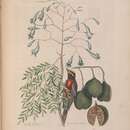mk
имиња во трошки


Jacaranda caerulea (boxwood or cancertree) is a flowering tree belonging to the genus Jacaranda. It is native to the West Indies, in Cuba, Hispaniola (the Dominican Republic and Haiti) and the Bahamas.[2][3]
Jacaranda caerula was described in 1805 by French naturalist Jean Henri Jaume Saint-Hilaire.[4] It grows up to 12 metres (39 ft) in height and has 40 cm long, bipinnate leaves each with 8 to 26 pinna.[5]
The flowers are purplish blue in colour with a tubular shape, being narrower towards the base and larger at the tip. They measure 3.5 to 4 cm long and 1 to 1.4 cm wide at the mouth.[5] It flowers intermittently throughout spring and summer, rather than having one big bloom during spring.[3]
The tree is native to the Bahamas, Hispaniola, and Cuba, but can also be found in Florida where it was introduced for landscaping purposes.[3] It most commonly found in limestone areas between sea level and 300m.[5]
The leaves are used in some places for their antiseptic properties. In the Bahamas, decoctions are made from the dried leaves and used as an alternative treatment for a variety of skin complaints, including skin cancer. In Cuba, decoctions of leafy branches are used to treat eczema and acne.[6]
![]() Data related to Jacaranda caerulea at Wikispecies
Data related to Jacaranda caerulea at Wikispecies
Jacaranda caerulea (boxwood or cancertree) is a flowering tree belonging to the genus Jacaranda. It is native to the West Indies, in Cuba, Hispaniola (the Dominican Republic and Haiti) and the Bahamas.